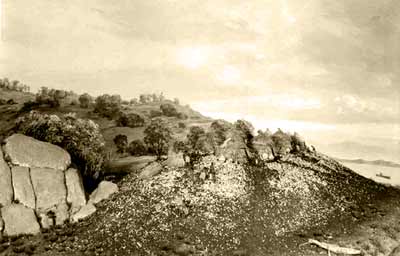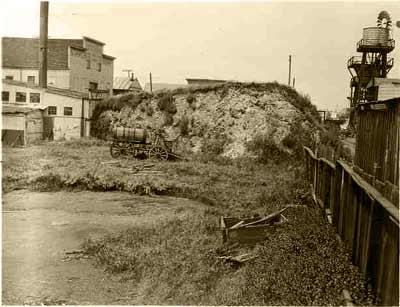|

|

|
NEWS
SEARCH
|
|
|
|

|
|

San Francisco Bay as it looked thousands of years
ago when the first people settled its shoreline.
The scene was created by Nels Nelson, a Berkeley
archaeologist who first began excavating shell mounds
of human, faunal and animal remains in 1902. Photo
courtesy of the Nels Nelson Archive, American Museum
of Natural History.
|
San
Francisco Bay: a 5,000-year perspective on the human transformation
of the bay
13 June 2002
By Diane Ainsworth, Public Affairs
Human habitation of the shoreline of San Francisco Bay
is as old as the bay itself - even older. However, says
anthropologist Kent Lightfoot, people today are altering
the bay's ecology more rapidly than did the native Americans
of millennia past.
Lightfoot
knows because he has logged a fair amount of time sifting
through shell mounds along the bay. They contain prehistoric
artifacts - built up from tons of rock, soil, ash and
shell - that were left by native Californians 4,000 to
5,000 years ago. First excavated in 1902, the mounds have
preserved human remains, graves, house floors, hearths,
roasting pits and other domestic features, and a diverse
range of animal and plant remains, left by local hunter-gatherers
who thrived along the bay shoreline.
"People
were here from the start, and that's pretty significant,"
says Lightfoot. "They witnessed the creation and
expansion of the San Francisco Bay system. They were here
when sea levels were much higher and the Golden Gate was
under water about 10,000 or 11,000 years ago. They've
been here ever since."
A
5,000-year perspective
Lightfoot
- who presented "A 5,000-year Perspective of the
Human Transformation of the Bay" recently, on behalf
of the Berkeley Natural History Museums - believes that
San Francisco Bay is "an excellent setting in which
to view the symbiotic relationship of humans and the environment
over the last 11,000 year."
Early
survey work by two Berkeley archaeologists, Max Uhle and
Nels Nelson, laid the groundwork. Just after the turn
of the century, they identified and recorded some 425
prehistoric shell mounds. Anthropologists now know that
the first native Californians lived on the Sonoma County
coast (Duncan's Landing), in the Los Vaqueros area of
Alameda County and at sites in Santa Clara County, about
10,000 years ago.
As
sea levels began to decline 4,000 years later and more
shoreline appeared, human settlements began to dot the
landscape, Lightfoot says. The San Francisco, San Pablo
and Suisun bays all started to emerge.
"Thousands
of acres of intertidal mud flats, and salt and brackish
tidal marshes, were beginning to take root and thrive
during the period of 6,000 to 2,000 years before present,"
he says. "The chronology of archaeological sites
follows the establishment of tidal wetlands around the
bay. The earliest bayshore sites date to about 5,000 to
4,000 years ago."
Pre-colonial
inhabitants
The
large number and size of the shell mounds- some covering
the length of two football fields side-by-side and rising
30 feet in the air - suggest that a fairly large population
of native Californians lived in the region long before
Spanish, Mexican and Russian peoples began to colonize
the area, says Lightfoot, who is also well known for his
archaeological investigations of Russian sites in northern
California.
Nelson,
in fact, was not able to find all of the mounds before
they were destroyed by urbanization. Early population
density has been difficult to estimate because of that,
Lightfoot says.
"On
the one hand, not all of these mounds were probably occupied
at the same time," he says. "Many appear to
have been used over multiple centuries, so we had overlapping
occupation spans. Certainly when early Spanish explorers
entered the Bay Area between 1769-1775, they described
very dense populations, with smoke rising from many villages
around the Bay."
Clearly,
bayshore people exploited a range of resources in prehistoric
America. Closer examination of the mounds reveals that
these indigenous peoples fed mostly on shellfish, including
bay mussels, Pacific oysters and bent-nose clams, and
hunted terrestrial mammals, such as elk, black-tailed
deer and pronghorn. Wolf, fox, bear, skunk and raccoon
also were part of their staple diet, Lightfoot says.
Masterful
fishermen
They
were masterful fishermen and traveled short distances
in tule balsas, small boats constructed from tule reeds
that could hold up to three people at a time. Paddles,
hooks, darts, spears, nets and clubs, all used to kill
sea mammals, including otters, harbor seals, fur seals
and sea lions, were recovered from the shell mounds.
Many
anthropologists subscribe to the popular theory that California
Indians "were not passive hunter-gatherers who simply
collected the fruits of a 'wild' and 'pristine' land,"
Lightfoot says, "but were nurturing land managers
who constructed a cultivated landscape through deliberate
human intervention over many centuries."
They
built and maintained habitats through techniques such
as tillage, controlled burning, pruning, weeding and seeding
the wildlands, he says.
Competing
theory
A
competing school of thought, first suggested by Nelson
and other early archaeologists, suggests that prehistoric
populations overexploited the shellfish beds in San Francisco
Bay, forcing later generations to find alternative food
sources. An abundance of mussel and oyster remains were
found in the lower (earlier) levels of the shell mounds,
Nelson reported in 1909. In addition, one mound at Ellis
Landing was estimated to contain more than 17 million
mollusk shells.
Later
anthropologists argued that Nelson's theory didn't hold
water, claiming instead that there was quite a bit of
variation in estuarine habitats in San Francisco Bay 4,000
to 5,000 years ago. Most of it was brought on by the silting
of the bay, rather than from changes in the Indians' dietary
preferences.
Lightfoot
believes there is truth in both of these scenarios: local
people were managing their environment while, at the same
time, exploiting and perhaps even overexploiting certain
primary food sources. "The critical point is that
prehistoric San Francisco was never a natural or pristine
wilderness," he says. "Its ecology has been
changing as long as people have lived here."
The
challenge for future stewards of the environment, however,
will be to find ways of safeguarding nature's ability
to renew natural resources, despite the swiftness with
which people today are altering the ecology.

The
large size and number of shell mounds found in the
Bay Area - this one is called the West Berkeley Mound
- suggest a fairly large population of native Californians
were living along the shore at least 5,000 years ago;
early 20th century UC Berkeley archaeologists Nels
Nelson and Max Uhle identified more than 425 ancient
mounds. Photo courtesy of the Nels Nelson Archive,
American Museum of Natural History. |
|

|